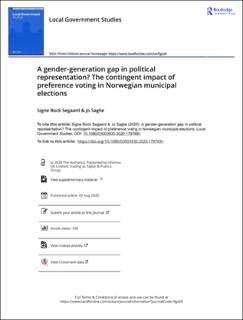| dc.contributor.author | Segaard, Signe Bock | |
| dc.contributor.author | Saglie, Jo | |
| dc.date.accessioned | 2020-08-14T07:18:03Z | |
| dc.date.available | 2020-08-14T07:18:03Z | |
| dc.date.created | 2020-08-12T17:56:55Z | |
| dc.date.issued | 2020 | |
| dc.identifier.issn | 0300-3930 | |
| dc.identifier.uri | https://hdl.handle.net/11250/2671947 | |
| dc.description.abstract | The article analyses the impact of preference votes on the gender balance in municipal councils in Norway, and to what extent this impact varies with candidates’ age, party and local context. We compare actual representation with a hypothetical closed-list outcome. The analyses show that both local political representation and the impact of preference votes are characterised by a gender-generation gap. Older women are underrepresented, while young women are represented on equal terms with young men. Young female candidates benefit from preference voting in larger municipalities, whereas the older generation of women loses out in both large and small municipalities. In conclusion, we argue that an intersectionality approach should pay more attention to variables other than ethnicity, including age and local context. Moreover, research on gender and political representation should take into account a gender-generation perspective. | |
| dc.language.iso | eng | |
| dc.relation.uri | https://www.tandfonline.com/doi/full/10.1080/03003930.2020.1797691 | |
| dc.title | A gender-generation gap in political representation? The contingent impact of preference voting in Norwegian municipal elections | |
| dc.type | Peer reviewed | |
| dc.type | Journal article | |
| dc.description.version | publishedVersion | |
| dc.source.journal | Local Government Studies | |
| dc.identifier.cristin | 1823059 | |
| dc.relation.project | Norges forskningsråd: 294597 | |
| dc.relation.project | Norges forskningsråd: 249687 | |
| cristin.ispublished | true | |
| cristin.fulltext | original | |
| cristin.qualitycode | 1 | |
